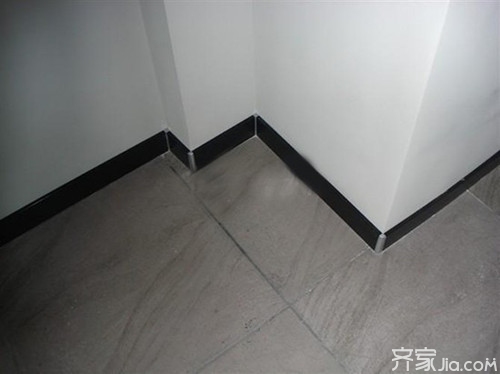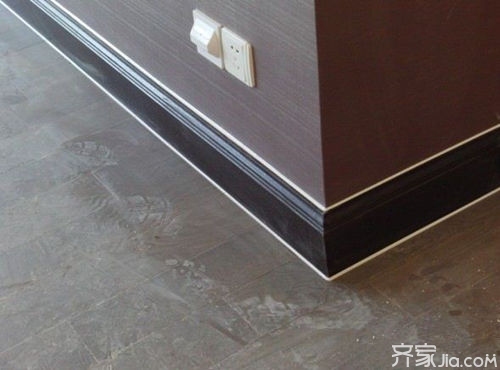The baseboard, as the name implies, is the wall area where the foot can kick. Therefore, in addition to the function of protecting the wall surface, the baseboard also has a certain role in home decoration. It is the outline of the interface between the ground and the wall. People's eyes often fall naturally on the baseboard. The next small series for everyone to introduce the tile baseboard how to paste and the type of baseboard. Tile baseboard how to paste 1, drilling Use a special tool to drill holes in the wall. Before drilling, observe whether there are any hydropower lines in the wall to prevent mistakes. The common length of the baseboard is 2m. In order to fix the skirting board more firmly, the drilling interval should be about 40cm, and the interval at the interface should be smaller. After you have drilled the hole, place a small stick in the hole. The nails fixing the baseboard are nailed to the wooden bar. The reason why it is not directly nailed to the wall is to prevent the nail from loosening. As the pipes of the hydropower project are buried on the wall, the location of the pipe is just below the switch socket. When drilling, it must be well positioned to avoid damage. 2, fixed Before the fixed baseboard, the wall should be leveled and cleaned. Otherwise, after the skirting board is installed, it cannot completely adhere to the wall, leaving unsightly gaps. Look for the drill hole and fix the nail on the baseboard. When fixing, pay attention to whether the skirting board and the wall are in close contact. The nail should be fully screwed into the hole to avoid affecting the effect. 3, corner treatment At the corner, where the baseboard meets, the edge of the baseboard is cut at a 45-degree angle so that the interface will not leave unsightly traces. The corner baseboard must be cut through a 45-degree angle before it can be spliced ​​and installed, otherwise it will affect the appearance. 4, installation points The fixed baseboard nails use special screw nails, so the fixing effect is better and it is not easy to loosen. In order to make the ground more beautiful, the intersection of the skirting line should be smoothed with a plane. And to make the skirting board completely close to the wall, no gaps, especially corners. The flatness of the wall should be tested before installation. Kinds of baseboards 1, ceramic baseboard: ceramic baseboard is divided into glazed tile baseboard and vitrified tile baseboard, if you choose ceramic material baseboard, it is generally recommended to choose the same as the floor tile material baseboard is appropriate, such as If you choose an antique brick, you can consider glazed skirting. If you choose a vitrified tile, consider a vitrified tile baseboard. 2, wooden baseboard: There are two kinds of solid wood and MDF production, solid wood is very rare. The cost is higher and the effect is better. It is necessary to pay attention to the phenomenon that the climate change will be arched in the future. 3, PVC skirting: is a cheap alternative to wood kicks, the appearance of the general imitated wooden kick, with a veneer showing the effect of wood or paint, cheap, but the skin may be off, and visual effects are also more than wooden kick Feet difference. 4, stainless steel baseboard: the cost is very high, the installation is also more complex, but durable, almost no maintenance trouble, but generally only suitable for some modern style of decoration. White, yellow, dark green oil and metal match, stainless steel baseboard or aluminum baseboard, has become part of this fashion decoration. 5, tile or stone baseboard: more durable, but generally suitable for the wall also use the stone or tile room. 6, PS polymer baseboard: instead of solid wood baseboard and stainless steel and its stone baseboard, etc., is essentially a plastic polymer as the main material, the surface of the use of wood or marble texture to decorate; advantages are waterproof, resistant Grinding, high surface finish; cost higher than PVC and MDF baseboards. 7. Wood-plastic baseboard: It is a new type of composite material that is currently booming in China. It refers to the use of polyethylene, polypropylene, polyvinyl chloride, etc., instead of the usual resin adhesive, with more than 35% -60% of wood. The powder is mixed into new wooden materials and then produced by the extrusion process. Mainly used as an alternative to solid wood baseboards and PVC baseboards. 8, artificial stone baseboard: artificial stone manufacturing technology has been progressing, according to the addition of color paste and different particles, from light to dark, from plain to particle-containing color, the market can see. Due to the physical and chemical characteristics of the artificial stone, a few meters of stone skirting can be seamlessly stitched on the site. There is no scar mark, and the smoothness of the point of view is everywhere. The construction process is not complicated. Just select the type and length of the skirting, and the professional will be able to splice it. It is reported that the raw materials of the artificial stone baseboard are mainly natural stone powder polyester resin, color paste pigment and aluminum hydroxide, so there is no need to worry about the radioactivity of the artificial stone baseboard. 9, glass skirting: glass-based material, after cutting, fine grinding, surface coating of high-quality imported nano materials. With crystal clear characteristics, it is the best choice for decorations, but the glass skirting is fragile and is not safe for use on the baseboard, especially for families with elderly people and children. Therefore, glass skirtings are only loved by those who are extremely decorative. Editor's summary: The type of tile baseboard and the type of baseboard are introduced here, and we hope to help everyone. If you want to know more related information, you can pay attention to this website information. Baseboard Installed Tile Baseboard Price Solenoid Pump
A solenoid pump is a type of positive displacement pump that uses an electromechanical solenoid to actuate a piston or diaphragm. These pumps are commonly used in a variety of applications, including chemical dosing, liquid transfer, and fluid metering. Solenoid pumps are typically compact, low-cost, and easy to install and maintain. They are also known for their high accuracy and precise flow control, making them ideal for applications that require precise dosing or metering of fluids.
We have Solenoid Air Pump, Solenoid Water Pump, both AC Solenoid Pump and DC Solenoid Pump are available. Each type has its own unique features and benefits, making it suitable for different applications.
Solenoid Pump,Solenoid Diaphragm Air Pump,Ac Mini Water Pump,Vibration Solenoid Pump Shenzhen DYX Technology Co.,Limited , https://www.dyxpump.com
